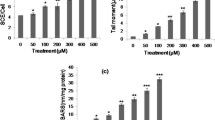Abstract
Numbers of studies have been carried out on the potential of lead genotoxicity. The mechanisms of lead genotoxicity are not fully known but partly attributed to the formation of highly reactive oxygen metabolites (ROM). However, lead ions have no ability to generate ROM. In this study, we have investigated the ability of lead and ALA to induce excision repairable DNA lesions by using cytosine arabinoside or cytokinesis block micronucleus (ARA-C/CBMN) assay. N-methyl-N-nitrosourea was used as a positive control which is a mutagen and known to induce excision repair. The results of the ARA-C/CBMN assay show that ALA exposures have significantly (p < 0.01) increased the ratio of excision repairable DNA lesions in peripheral blood lymphocytes; however, lead have not. Accordingly, accumulation of ALA should be considered as an effective partner of lead induced DNA damage in lead exposure.


Similar content being viewed by others
References
Rousseau MC, Parent ME, St-Pierre Y (2008) Potential health effects from non-specific stimulation of the immune function in early age: the example of BCG vaccination. Pediatr Allergy Immunol 19(5):438–448
Danadevi K, Rozati R, Saleha B, Banu P, Hanumanth R, Grover P (2003) DNA damage in workers exposed to lead using comet assay. Toxicology 187(2–3):183–193
Vaglenov A, Creus A, Laltchev S, Petkova V, Pavlova S, Marcos R (2001) Occupational exposure to lead and induction of genetic damage. Environ Health Perspect. 109(3):295–298
Pasha Shaik A, Sankar S, Reddy SC, Das PG, Jamil K (2006) Lead-induced genotoxicity in lymphocytes from peripheral blood samples of humans: in vitro studies. Drug Chem Toxicol. 29(1):111–124
Süzen HS, Duydu Y, Aydin A, Işimer A, Vural N (2003) Influence of the delta-aminolevulinic acid dehydratase (ALAD) polymorphism on biomarkers of lead exposure in Turkish storage battery manufacturing workers. Am. J. Ind. Med 43(2):165–171
International Agency for Research on Cancer (2006) IARC monographs on the evaluation of carcinogenic risks to humans. Inorganic and organic lead compounds, vol. 87. IARC, Lyon
Stoleski S, Karadzinska-Bislimovska J, Stikova E, Risteska-Kuc S, Mijakoski D, Minov J (2008) Adverse effects in workers exposed to inorganic lead. Arh Hig Rada Toksikol 59(1):19–29
Hartwig A, Schlepegrell R, Beyersmann D (1990) Indirect mechanism of lead-induced genotoxicity in cultured mammalian cells. Mut Res 241(1):75–82
Steenland K, Boffetta P (2000) Lead and cancer in humans: where are we now. Am J Ind Med 38(3):295–299
Restrepo HG, Sicard D, Torres MM (2000) DNA damage and repair in cells of lead exposed people. Am J Ind Med 38(3):330–334
Winder C, Bonin T (1993) The genotoxicity of lead. Mutat Res 285(1):117–124
Mascıo P, Teıxeıra PC, Onukı J, Medeıros MHG, Dornemann D, Doukı T, Cadet J (2000) DNA damage by 5-aminolevulinic and 4,5-dioxovaleric acids in the presence of ferritin. Arch Biochem Biophys 373(2):368–374
Duydu Y, Süzen HS (2003) Influence of delta-aminolevulinic acid dehydratase (ALAD) polymorphism on the frequency of sister chromatid exchange (SCE) and the number of high-frequency cells (HFCs) in lymphocytes from lead-exposed workers. Mutat Res 540(1):79–88
Ustundag A, Duydu Y (2007) The influence of melatonin and N-acetylcysteine in delta-aminolevulinic acid and lead induced genotoxicity in lymphocytes in vitro. Biol. Trace Elem. Res 117(1–3):53–64
Duydu Y, Dur A, Süzen HS (2005) Evaluation of increased proportion of cells with unusually high sister chromatid exchange counts as a cytogenetic biomarker for lead exposure. Biol Trace Elem Res 104(2):121–129
Duydu Y, Süzen HS, Aydin A, Cander O, Uysal H, Işimer A, Vural N (2001) Correlation between lead exposure indicators and sister chromatid exchange (SCE) frequencies in lymphocytes from inorganic lead exposed workers. Arch Environ Contam Toxicol 41(2):241–246
Moore MR, Goldberg A, Laıwah AACY (1987) Lead effects on the heme biosynthetic pathway. Annal New York Acad Sci 514:191–203
Fiedler DM, Eckl PM, Krammer B (1996) Does delta-aminolaevulinic acid induce genotoxic effects. J Photochem Photobiol B 33(1):39–44
Neal R, Yang P, Fiechtl J, Yıldız D, Gurer H, Ercal N (1997) Pro-oxidant effects of delta-aminolevulinic acid (delta-ALA) on Chinese hamster ovary (CHO) cells. Toxicol Lett 91(3):169–178
Noriega GO, Tomaro ML, del Batlle AM (2003) Bilirubin is highly effective in preventing in vivo delta-aminolevulinic acid-induced oxidative cell damage. Biochim Biophys Acta 1638(2):173–178
Valovicova, Gabelova (2004) Effect of cytosine arabinoside and hydroxyurea on micronucleus formation induced by model clastogens in Chinese hamster V79 cells. Neoplasma 51(6):442–449
Fenech, Rinaldi J, Surralles J (1994) The origin of micronuclei induced by cytosine arabinoside and its synergistic interaction with hydroxyurea in human lymphocytes. Mutagenesis 9(3):273–277
Leopardi P, Zijno A, Marcon F, Conti L, Carere A, Verdina A, Galati R, Tomei F, Baccolo TP, Crebelli R (2003) Analysis of micronuclei in peripheral blood lymphocytes of traffic wardens: effects of exposure, metabolic genotypes, and inhibition of excision repair in vitro by ARA-C. Environ Mol Mutagen 41(2):126–130
Surralles J, Xamena N, Creus A, Marcos R (1995) The suitability of the micronucleus assay in human lymphocytes as a new biomarker of excision repair. Mut Res 342(1–2):43–59
Fenech M, Neville S (1992) Conversion of excision-repairable DNA lesions to micronuclei within one cell cycle in human lymphocytes. Environ Mol Mutagen 19(1):27–36
Kirsch-Volders M, Fenech M (2001) Inclusion of micronuclei in non-divided mononuclear lymphocytes and necrosis/apoptosis may provide a more comprehensive cytokinesis block micronucleus assay for biomonitoring purposes. Mutagenesis 16(1):51–58
Fenech M (1993) The cytokinesis-block micronucleus technique and its application to genotoxicity studies in human populations. Environ Health Perspect 101(3):101–107
Fenech M, Morley AA (1985) Measurement of micronuclei in lymphocytes. Mut Res 147:29–36
Author information
Authors and Affiliations
Corresponding author
Rights and permissions
About this article
Cite this article
Ustundag, A., Duydu, Y. Induction of Excision Repairable DNA Lesions in Lymphocytes Exposed to Lead and ALA In Vitro. Biol Trace Elem Res 128, 31–37 (2009). https://doi.org/10.1007/s12011-008-8254-0
Received:
Accepted:
Published:
Issue Date:
DOI: https://doi.org/10.1007/s12011-008-8254-0




